I’m currently on an actual road trip to the Midwest conducting research for a new book. I hope to back in the office Saturday afternoon and, if all goes as planned, I’ll post the real Weekend Road Trip photos at that time.
Enjoy your weekend.
I’m currently on an actual road trip to the Midwest conducting research for a new book. I hope to back in the office Saturday afternoon and, if all goes as planned, I’ll post the real Weekend Road Trip photos at that time.
Enjoy your weekend.
Seargent Leslie (Les) Wilmont – Kiefer, Oklahoma Police Department
Sergeant Wilmont, a 30 year veteran and former police chief, was killed when his patrol car struck a tractor trailer.
Deputy Sheriff Michael Sean Thomas – Bibb County, Georgia Sheriff’s Office

Deputy Thomas, an eight year veteran, died May 25, 2008 of injuries he’d received in April when his police motorcycle collided with a pickup truck. The driver of the truck pulled out in front of Deputy Thomas as he approached an intersection.
Deputy Sheriff James Throne – Kern County, California Sheriff’s Office
Deputy Throne was killed May 23, 2008 when his patrol car collided with another patrol car while responding to assist other officers.
Sheila Lowe is a forensic handwriting expert with more forty years of experience in the field. She holds a Bachelor of Science degree in psychology and is the author of several published books including Handwriting of the Famous & Infamous, and The Complete Idiot’s Guide to Handwriting Analysis, as well as Sheila Lowe’s Handwriting Analyzer software. Her first mystery novel, Poison Pen, received a starred review in Publishers Weekly and introduces forensic handwriting expert, Claudia Rose, who uses her handwriting analysis skills to help solve crimes. Www.sheilalowe.com for information about handwriting analysis. Www.claudiaroseseries.com to read a sample chapter and view a book trailer. Www.superceu.com continuing education for marriage and family therapists and licensed clinical social workers. Sheila@sheilalowe.com
Can Handwriting Reveal a Serial Killer?
He was handsome, charismatic, captivating. He was convicted of the rape and murder of ten women in Florida. He’d probably raped at least fifty.
As with other violent crimes, serial murder is on the increase. Between 1900-1950, an average of 1.2 cases a year were recorded. In 1960 there were 12 cases. By the 1980s this offense had jumped to an average of two cases a month. Since 1977 more than two hundred serial killers have been convicted, with well over a thousand victims between them. More than 80% of all serial murders have occurred in less than 30 years.
Like others of his ilk, serial murderer Robert Joseph Long managed to elude capture over a lengthy period–how? Because he was able to look and act pretty much like the average guy. He knew how to fit into society and appear like the rest of us. But his handwriting held clues that pointed to pathological behavior.
Most people agree that the way a person walks says a lot about him. Someone who swaggers into a room, for example, has a very different personality from one who diffidently creeps along, hugging the wall. Researchers tell us that facial expressions are interpreted the same way the world over, and one’s tone of voice indicates his mood. Similarly, handwriting is a projective behavior akin to body language, tone of voice, and facial expression, and it reveals a important information about motivation and personality, the good, the bad, and the ugly.
Having said that, let me be very clear that there is no such thing as a “criminal handwriting.” In an attempt to identify patterns of similarity in the handwritings of serial killers, I examined the handwritings of a number of notorious murderers. What I discovered was, there was no direct “this-means-that” correlation of a personality trait to a handwriting characteristic; it was far more subtle than that.
It would have been handy if we could neatly package up a syndrome of traits and instantly identify a serial killer or any other type of criminal, but what actually manifests in handwriting are red flags for certain types of pathological behavior, or the potential for it. Because what we see written on a sheet of paper is like a photograph of the past, the handwriting professional can make some extrapolations, but cannot absolutely predict future behavior.
With the exception of Wesley Allan Dodd, the handwritings available for my examination were written after incarceration, when these men and women were forced to toe the mark and curb their deadly appetites. The restraint they had to practice–the need to follow strict prison rules–had an effect on their handwriting, making it appear far more rigid and controlled than in the time leading up to a kill, when their murderous rage was building to a breaking point.
Robert Joseph Long, mentioned in the introduction to this article, has been described as “shockingly brutal.” He beat, raped, and strangled his victims. Long’s handwriting is rigid to an extreme, seen in the tight, angular forms, which indicates a lack of emotional release. Positive emotional release would be seen in a balance of rounded and angular forms. Note the extremely long t-crosses. This straight horizontal movement, combined with the rigidity, reveals his need to dominate and control others.
Wesley Allan Dodd, executed at his own request by hanging in 1993, kept a diary during the time he was killing little boys. His handwriting during the time leading up to a killing is far more “released” (though not in a positive way) and expansive than the second sample, written after he was convicted. You don’t have to be a handwriting expert to see the difference in the two samples. The second one is reminiscent of Bob Long’s, highly controlled and rigid, while the first is out of control.
Serial murder is not confined to male perpetrators. Aileen Wuornos, the subject of the movie, Monster, was executed in 2002 for the deaths of seven men. Christine Slaughter Falling (talk about an appropriate name!), whose handwriting appears below, is a very different personality type, but just as deadly. She was accused of killing at least six infants and toddlers she babysat, and was convicted of three counts of murder in 1982, receiving a life sentence that made her eligible for parole in 25 years. In an interview for CNN in 1992, Falling was asked what she would do if released. Her answer: she would like to babysit again, because, “I love kids to death.” She was denied parole in 2006.
Her handwriting sample, written after 10 years of incarceration, is the polar opposite of Dodd’s and Long’s. The extreme roundedness of the writing and the large size, suggest an egocentric person who was constantly seeking love and approval (though clearly, not in healthy ways). The letters “M” on “Me” and “R” on “really” are made in such a way that they look like an X. Such forms are often made by people with a death consciousness, sometimes by one who has experienced a death close to them, or perhaps have received a serious diagnosis of physical illness. In Falling’s case, perhaps her responsibility for the deaths of several young children was on her mind–though not her conscience. This handwriting specimen wasn’t made by someone with a conscience.
Another fairly rare characteristic in Falling’s handwriting is seen in some of the upper loops, such as the “l” on “letter,” which are made in the shape of a candle flame. The flame-shaped upper loop is often seen in one who has sustained a blow to the head. It’s known that when Christine was 8 years old, her mother (who was a 16 year-old-prostitute when Christine was born), hit her in the head with a two-by-four, after which she began having seizures. These flame-shaped loops are often created by those who tend to see the world quite differently than most of us do.
Most, if not all, serial killers came from childhoods where they were abused and/or neglected. Yet, comparatively few abused children grow up to be killers or engage in other types of crime. Many factors, both nature and nurture come into play. Genetics, environment, and the individual’s personal responses to a variety of experiences blend together to determine the outcome.
Handwriting, like personality, is made up of thousands of variables. In order to make any kind of objective assessment, it is important to study the whole picture, not just bits and pieces. The characteristics described above were viewed within the context of larger samples of writing, and are intended only as an teaser to what kinds of information is revealed. Handwriting cannot tell everything about the writer, but it can open a window into the mind, both of the criminal and the “normal” person. Some psychologists find it helps them to get a rapid grasp on what makes a person tick–whether the writer is motivated by the need for power, the need for security, the need to be loved, etc. Especially when used in conjunction with other personality assessment instruments, handwriting analysis can be an important tool for understanding the human psyche.
* * *
< * Any typos are all mine (Lee). I posted this last night in a hotel lobby at midnight. Sorry, Sheila.
Unsure of what she wanted to be after college, T. Lynn explored various careers including commercial tread rubber sales and retail management. For one summer, her job was to scare people at a haunted house, but that was a long time ago. Most recently, she was a television producer for several years before leaving the corporate career world so that she could make stuff up on a fulltime basis.
She also writes freelance and her articles appear in regional magazines across the country. (To read a few, click on the ‘Musings’ tab.)
When not vacuuming up pet hair, T. Lynn enjoys photography, doing absolutely nothing anywhere with a terrific view, and taking impromptu road trips in the name of research.
T. Lynn is also a certified firearms safety instructor and shooting sports enthusiast. She lives in Myrtle Beach, South Carolina with her husband and a few furry critters.
T. Lynn Ocean:
Put most any man (who is not a seasoned gun collector) in front of a gun counter, tell him to pick one, and chances are good that he’ll go for the largest caliber thing he sees. It must be a guy thing. Take, for example, the 2007 NRA Gun of the Year: a Smith & Wesson 460XVR revolver that uses magnum loads. (Friends of the NRA hosts fundraising banquets around the country and they always choose a gun, knife, and print of the year, which become collector items.) FYI, if you haven’t seen one, this gun is huge! Of course, the NRA goes out of their way to be female friendly, but I’d guess that it was an all-male committee who chose the .460 SW Magnum as their coveted gun of the year.
Touted as the highest velocity revolver in the world, this gun has an extra large frame, weighs more than 5 pounds when loaded, and has an overall length of 15″.
I’m no ballistics expert, but generally speaking, the higher the caliber, the more recoil. And the more recoil, the less controllability a shooter has, especially anything beyond the first shot.
Why on earth would any woman (fictional character or otherwise) carry a weapon that will beat her up when she shoots it? Many law enforcement folks—including my local PD—use .40 caliber Glocks for their duty weapons. I shot one at the indoor range last month and literally stopped before I even emptied the magazine. Can you say, ouch! I shot with a firm, two handed grip and well balanced stance. But my wrist really hurt after only six or seven rounds. My shooting buddy, a guy, agreed that the recoil was rough. But he quickly added that the Glock’s recoil didn’t bother him. Of course it didn’t. His wrists are the size of drink coasters. The ‘kick’ factor might not bother most men, but if I were a female officer toting around a .40 Glock, I couldn’t begin to imagine what my wrist and arm would feel like after target practice. Not only would I not want to practice, but I’d dread doing so. I liken it to asking a marathon runner to train in high heels.
Law enforcement decision-makers must take into account many factors when doing a weapons buy. But for your average private investigator, retail store manager, lawyer, grandma, or jewel thief who carries a weapon, there is absolutely no reason to adhere to the old adage: the bigger the caliber the better.
Like everything else—from golf clubs to passenger tires—improved technology has made handgun ammunition much more effective than ever before. Stopping power IS available with smaller caliber weapons.
Most everyone is familiar with JHP, or jacketed hollow-points. Such bullets, as the name suggests, have a hollowed out space in the nose and are designed to ‘mushroom’ out, or expand upon impact. The development of hollow-point ammo was one giant step in creating good stopping power for lower caliber weapons. As an added benefit, the expanded chunk of lead is less likely to go all the way through the bad guy, and if it does, chances are it won’t have enough velocity to maim an innocent passerby.
9mm fired: A 9mm Hydra-Shok bullet that was fired into water jugs
Even better is the relatively new Hydra-Shok technology, available in Federal Premium ammo. (You’ll hear it called hydroshock among other names, but note that Hydra-Shok is a registered trademark.) Bottom line? Take a hollow-point bullet and add a small post in the center of it. The result is even MORE—yes more—stopping power. It’s something to do with energy transfer and penetration and the fact that the human body is about 60% water. I’m told that, even if the assailant is hit in the arm or leg rather than at center mass, a Hydra-Shok bullet will bring him down. Plus, most shooters in a self defense situation will keep pulling the trigger until the threat has been eliminated. Even cops with .40 caliber Glocks don’t stop after one shot when their life is on the line.
9mm Round: A 9mm Hydra-Shok round. It’s hard to see, but note the center post sticking up in the hollowed cavity. Also note the scored edges–these are the points where the bullet will rip open upon impact.
I just got the newly-introduced Ruger SR9 and love it. It’s slim and sexy and has a magazine capacity of 17 rounds. And loaded with Hydra-Shok, this 9mm has plenty of stopping power for any run-of-the-mill self defense situation. (Meaning you’re not up again terrorists with shoulder mounted rocket launchers.) Best of all, I shot about 200 rounds through the SR9 during one practice session, and went home with a happy wrist.
Ruger SR9: The Ruger SR9’s overall length is just over 7.5″ and its width is a surprising 1.27″. In the interest of safety, I must mention that the early production SR9s have been recalled due to possibly firing if dropped. It’s an easy fix and Ruger is giving a free magazine to those affected. But if you’re running out to purchase one, check the serial number first. You can find recall info at ruger.com.
A good firearms instructor will offer this advice to anyone shopping for a self defense gun: Buy the biggest caliber that you can comfortably and accurately handle. I always add a few additional words of advice: Buy something that you will not only practice with, but enjoy shooting. I’ve found that if a person enjoys shooting a particular gun, they’re much more apt to practice with it.
That means that women—including your gun-toting female characters—might want to forget about “bigger is better” and go with a smarter choice. Let’s face it. We just don’t have the upper body strength that a man does. Our forearms don’t have the same muscle mass, even if we are eating all our spinach. And most of us don’t have wrists the size of coasters. Why deal with uncomfortable recoil when we don’t have to?
Of course, if your character is in law enforcement, they may not have a choice as to what they carry on the job. And on the opposite end of the spectrum is the proverbial professional assassin who carries a small .22 since they know how to administer a well-placed head shot at point blank range. If done right, the low velocity bullet bounces around inside the skull enough to cause fatal damage.
But for the rest of us, a 9 millimeter, a .38, or even a .380 loaded with Hydra-Shok ammo should do just fine.
* * *
You can visit T. Lynn Ocean at www.tlynnocean.com
* * *
We’ve just been informed that Earle Hagen, the writer (and whistler) of the Andy Griffith Show theme song died yesterday at age 88.
Lori L. Lake is the author of Snow Moon Rising, a novel of survival set during World War II, which received a 2007 Golden Crown Literary Award as well as the 2007 Ann Bannon Popular Choice Award. She is the creator of the “Gun” series, which is a trilogy consisting of romance/police procedurals Gun Shy and Under The Gun and the adventure/thriller Have Gun We’ll Travel. Her first novel, Ricochet In Time, was about a hate crime. She has also written two books of short stories, a standalone romance, and edited two story anthologies. Lori teaches fiction writing courses at The Loft Literary Center, the largest independent writing community in the nation. She lives in Minnesota with her partner of 27 years and is currently at work on a mystery series and a How-To Book about the craft of writing. For more information, see her website at www.lorillake.com.
Part 2: Size DOES Matter
Everything about firearms indicates that size matters, especially in terms of cartridges, caliber, and bore.
All firearms are designed to take a specific kind of cartridge, and there are scores of different types and sizes of cartridges (or ammunition, which some people mistakenly refer to as “bullets”). You must use the correct ammunition in the firearm. You can be injured or even killed if the wrong cartridge is used. Why is this?
Even if you manage to load the cylinder of a revolver or get a particular cartridge into a gun’s chamber, if you attempt to fire ammo that is too big to fit through the barrel, the gun can literally blow up in your hand. If the cartridge is too small, the gun could misfire, or the bullet could tumble out in a completely inaccurate manner and miss what you’re aiming at.
Every gun has a specific-sized bore that takes a specific-size caliber. The bore is the diameter of the inside of the gun’s barrel through which the bullet travels when a gun is fired.
Caliber describes the size of the cartridge designed for a specific bore. The diameter of the barrel (the bore) is basically the same as the caliber the gun uses. The diagram below (which is not quite fully to scale) illustrates this:
The caliber (size of bullet, left) has to fit the bore (right).
Caliber is expressed in terms of inches or millimeters. A .22 cartridge, for instance, is just a hair under a quarter-inch in diameter. The photo below gives an excellent visual of various calibers:
Common handgun cartridges (left to right): 3-inch 12-gauge magnum shotgun shell (for comparison), size “AA” battery (for comparison), .454 Casull, .45 Winchester Magnum, .44 Remington Magnum, .357 Magnum, .38 Special, .45 ACP, .38 Super, 9 mm Luger, .32 ACP, .22 LR
As you can tell, a bullet from, say, that wicked-looking .454 Casull is going to pack a real punch. Can you imagine how painful it would be to be shot with a bullet nearly as big as a double-A battery? Ouch! The .22 cartridge is much smaller in contrast.
But Where Does the *Bullet* Come From?
I keep using the term cartridge. You can also call it ammunition or a round. But the bullet is only part of a cartridge. Pistol and rifle cartridges have four basic components:
The case is the brass cylinder that all the other parts fit into.
The primer is the component that the hammer of the gun hits and ignites.
Powder is the chemical compound ignited by the primer that propels the bullet.
The bullet is a projectile, usually made of lead and other metals, that the powder fires out the barrel of the gun.
Pulling the trigger creates a simple chain reaction: the firing pin strikes, primer ignites to flare and ignite the powder, which instantly generates a huge volume of gas that creates so much pressure, the bullet explodes from the case and out the barrel.
And it all happens in a split second.
One More Thing about Ammo
Shotgun shells are different from rifle and pistol cartridges. In addition to a case, primer, and powder, there is also a wad of plastic or fiber separating the shot from the powder. The wad forms a seal to allow the gases from the burning powder to push the shot down the barrel in a uniform manner. Instead of a bullet, shells are filled with “shot” – small, round pellets usually made of lead or steel. A shotgun shell can contain anywhere from a half-dozen ball-bearing-type pieces of metal to 1,300 pellets. It can also contain a slug, which is a solid piece of metal.
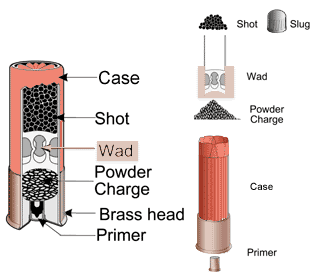
Police usually carry a shotgun in their cruisers, so if you have police characters in your stories, it’ll be important to use the correct terminology. If you’d like to learn a lot more about shotguns, this site walks you through all the angles: http://science.howstuffworks.com/shotgun.htm.
Using Firearms to Characterize
If you caught last week’s blog on “Guns, Guns, Guns,” you know that I believe the use of firearms in a crime novel can and should be used to characterize. Your gun choices add telling information about your story people. Some readers will not be able to tell a Kel-Tec from Manolo Blahniks, but for those well-versed in firearms (or shoes), name brands, styles, sizes, and other details do matter.
Lest you think that knowledge of guns and weaponry is not all that widespread, the National Rifle Association (NRA) has well over four million members. How many of them read crime fiction? I’ll bet a lot of them read thrillers, action, mystery, and adventure novels, as might the estimated thirty million hunters in the U.S. or the fifty million other Americans who own firearms. Men, in particular, notice the dearth of (in inaccuracy) of firearms lingo in novels, so if you want to increase your believability – and perhaps your audience – it’s important to have a good understanding of firearms and weaponry if you use them in your fiction.
You definitely do not want to bandy about terminology or firearm effects if you don’t know for sure that the details are correct. For instance, I recently read a manuscript where the author had terrorists carry Kalashnikovs down a crowded New York street on the way to the embassy they’re attacking. She had heard that Muslim extremists would probably use that sort of weapon.
Unfortunately, a Kalashnikov is a big mother of a weapon, an AK-47 assault rifle recognizable by its half-wood/half-steel construction and the curved magazine that holds 30 rounds. It’s also three feet long and weighs well over ten pounds fully loaded. If your terrorists walked through Time Square carrying Kalashnikovs, not only would everybody they encountered run screaming, but very little time would pass before a horde of NY City’s Finest descended and took them out. (More on Kalashnikovs in Part III.)
So, when choosing firearms for our characters, we know we want to be specific, but we also want our choices to be accurate and supportable given the context of the story and the characters’ situations.
I don’t mean to be un-PC or offensive to anyone, but we do have to differentiate regarding size, and one of the general dividing lines is gender. Even though women are certainly taller these days, men still tend to have bigger, more muscled frames and possess larger, stronger hands. Men probably have a greater selection of firearms to choose from because they’re comfortable with the wide variety of BIG guns.
Good Guns For Guys
If your sleuth/detective is a cop (or professional PI working for a large organization), he will be expected to carry a standard type of gun during work hours, usually a large-frame, large caliber semi-auto. But off the job, for concealment purposes, most cops and pros leave their work weapon at home or in their locker and opt for much smaller, lighter guns. (Note: If he’s a police officer, he’s going to have to qualify at the range with any weapon he carries off-duty.)
And if your sleuth is an amateur detective or PI, what might he carry?
A guy who grew up around guns, who hunted game with family members, or who’s always been interested in firearms may own several handguns from which to choose. You’ll have to decide whether your sleuth keeps an arsenal – or just one gun for personal protection.
A fellow who’s not such a gun enthusiast may, indeed, carry exactly the same gun as his department requires. That’s less to keep track of. A Glock 19 or 20 weighs about 28 ounces unloaded. With a full magazine of ammo, you can add another 11 or 12 ounces. That’s 40 ounces – or 2.5 pounds – of clunky weapon to lug around. Glock duty sidearms aren’t the slimmer, smaller version (like the Glock 36, for instance). They’re bulky and hard to conceal. Same goes for all of the full-size, large-frame semi-autos: the Beretta, the Kimber 1911, the various Smith & Wessons, etc., and they’re even heavier than a Glock.
So he may choose a lighter, easier-to-conceal firearm. What’s his personality all about? Is he a tough guy? Unassuming? Mr. Milquetoast in public, but hell on wheels when up against the wall? Does he have money to burn on the most expensive types of weapons? Or does he need to conserve his funds? (Keep in mind that ammunition is not cheap. A box of 50 rounds of .45 cartridges will run you about $40 in most sporting goods stores).
Is he nostalgic and carries a Walther P-38 like the ones used on “The Man from UNCLE”?
Or the .635mm Beretta 418 Ian Fleming had James Bond use in the first several books?
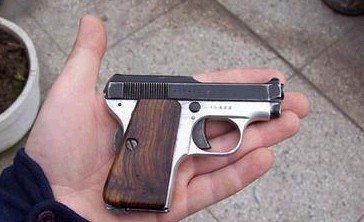
Or maybe the Walther PPK that Bond used most the time as his main gun?
Or the bigger, meaner-looking 9mm Walther – complete with a silencer – used in the latest James Bond
movies?
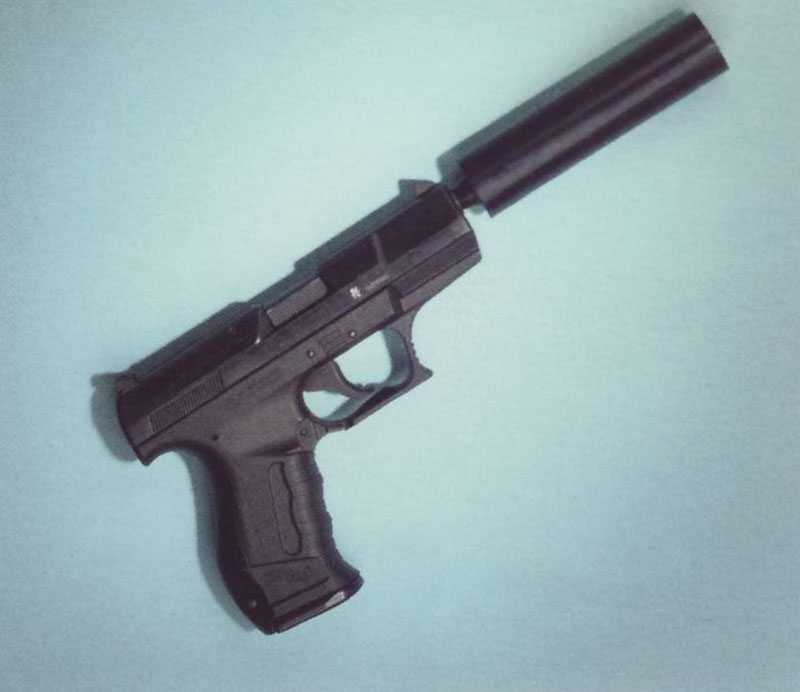
Robert B. Parker’s Spenser is often armed with a Smith & Wesson .38 Special (or .357 Magnum revolvers). He’s been carrying the .38 for so long that I suspect it might look like one of these older Model M60s:
Spenser’s best bud, Hawk, usually has an arsenal, including his favorite great big stainless-steel .357 Colt Python:
Or how about Indiana Jones’ British double action revolver, a late 19th Century .455 Webley Mk VI, which, by the way, he’s still using in 1957! I just saw the new movie over Memorial Day weekend, and he got this gun out:
In Terminator 2: Judgment Day, Arnold Schwarzenegger’s character used a Winchester Model 1887 10-gauge shotgun in many of the battle scenes against the T-1000. It had a modified loop near the trigger that allowed Schwarzenegger to “flip-cock” the shotgun in a memorable and dramatic manner.
All of these guns characterize in interesting ways, don’t they? Somehow, they seem to *belong* with their user.
Most men have the advantage of an easier time carrying guns on their person. They often use concealment holsters worn under clothing or in front or rear pants pockets. There are holsters made for one or double shoulder, waistband, side, back, ankle, hip, belly, etc. (To see a huge array of examples: http://www.holsterss.com).
Good Guns For Gals
Whether it’s PC to admit or not, women’s upper bodies are often nowhere near as strong as men’s. Granted, some women do have plenty of strength to handle anything the big boys do, but the fact remains that guns and equipment can be problematic for women. My police friends complain about their duty belts, for instance, and often it takes a lot of adapting to get accustomed to firing the department-issue firearm. To make matters more difficult, women have wider hips and bustlines, so holsters can be uncomfortable.
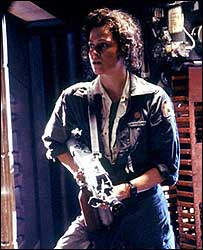
Sigourney Weaver in “Alien”
Not everyone is 5’11” like the actress Sigourney Weaver who pulled off the Ripley character carrying a massive plasma weapon that had to weigh a ton. And no women – and few men! – are anywhere near the size and strength of Lee Child’s 6’5” 240-pound Jack Reacher. (In fact, Reacher’s hand are probably so big, I bet he couldn’t even get his index finger comfortably into .22 or .25 handgun, much less a derringer.)
If I remember correctly, Nevada Barr’s Anna Pigeon and Sue Grafton’s Kinsey Millhone are both under 5’4”. Kinsey carries an unspecified .32. Stephanie Plum carries an unspecified .38 revolver in her purse (or forgets it in the cookie jar at home).
Lara Croft, from the popular game series (and in the movie) uses twin 9mm Heckler and Koch USP Match with speed-loader clips. When she ejects the magazines, a rack in her backpack comes out with a new set so she can sweep her arms behind and reload.
Angelina Jolie in “Lara Croft: Tomb Raider”
But how realistic is that for a female crime fiction sleuth, especially off-duty? Women may not have the advantage of suit jackets, underarm holsters, or big pockets and are likely to have interesting problems that many men might not have. Where doe she carry her weapon if she wants it concealed? On her person she can use ankle or thigh holsters. If she doesn’t mind the gun showing, she can wear it on a belt at her waist, but how tacky is that when you’re out with your boyfriend or taking your elderly mother to the dentist?
Women often carry their weapons in their purses, and this is where Glocks (and other guns without standard safeties) are problematic. There is no standard/external safety on a Glock. Experts will tell you that the “safety” consists of fully engaging the trigger, pulling it a full half-inch, and exerting 5 or 6 pounds of pressure before it fires. Having recently tested three different-sized Glocks by firing multiple rounds from each, I can tell you that the difference between the Glock trigger pull and, say, a .45 Colt revolver or a .40 SIG-Sauer is not great enough for me to have noticed.
So imagine this: Your sleuth sticks her big old bulky Glock in her dainty, evening purse. Along with the extra magazine of 9mm ammunition she might also want to carry, she’s lugging around three pounds of hardware. (Go get three pounds of hamburger, tuck that in your purse, and see how long it takes before your shoulder or arm is seriously fatigued. Of course you can always use the purse as a lethal weapon.)
Now, have your sleuth character sit in a booth with a reputed mobster she’s trying to cozy up to. It’s time to go to the powder room to check in with her handler. She reaches into her purse for her makeup case, accidentally hooks the Glock trigger on the case’s snap, and in the process of trying to disentangle it, the gun goes off. Of course it won’t hit the gangster. She’ll shoot herself in one elegantly panty-hosed foot. Or somebody else will get hit by the ricochet. Not good!
A heftier, bigger man may have less trouble stashing a Glock because he can tuck it into a holster in the back of his pants, stuff it in a trouser pocket, or use a shoulder holster. But nothing looks worse on a woman than that unsightly bulge just below the panty-line of her lovely evening gown.
A woman isn’t going to need the firepower of a Glock (9mm or .45 caliber, that is) anyway. She’s only carrying this gun around with her for personal, close-up, off-duty protection. So why not outfit her with a gun that not only suits her personality, but also has an external safety and is a size that she can comfortably carry? Here are three excellent purse guns:
.32 Beretta Tomcat 3032 – weighs about 16 oz. loaded with seven shells
.32 Bersa Thunder Conceal Carry – weighs about 22 oz. loaded with seven shells
.32 Kel-Tec P-32 – weighs a mere 15 oz. loaded with seven shells
That Kel-Tec is made with of the same kind of molded polymer that Glocks are made of, which makes it very lightweight. And look how much cuter it is!
As you can see, these are all sub-compact handguns, but what more does a gal need out on a date, doing her shopping, or driving around town? Besides, why advertise that she’s carrying? These are easy to hide on one’s person – in a pocket, in a mesh ankle holder, or tucked in a fanny-pack. They’re terrific for athletic pursuits. If your sleuth is a jogger or biker, you can outfit her with a special waist holders that hug them close.
You’ll notice none of the purse guns are under .32 caliber. There are a lot of .22 and .25 caliber guns out there, but I’m of the opinion that they lack stopping power to put down a determined assailant. Also, their barrels are so stubby that they’re hard to sight which makes it difficult to accurately hit anything at more than spitting distance, especially because they’re so light that the recoil causes them to flip around with every shot you take.
But just in case you want to see a really dinky ladies gun that some women swear by and that travels well in a purse, here is one:
.25 American Derringer LM5 – weighs about 18 oz. loaded with five shells
See how there’s hardly any barrel to sight down? This gun – and all of the tiniest sub-compacts – are going to be very inaccurate weapons.
If your female detective – or your male detective, for that matter – wants more firepower and doesn’t mind some extra weight, these are good compacts that are still small and concealable, but that you may find are a lot easier to aim and hit the target:
.380 Walther PPK/S – weighs about 26 oz. loaded with eight shells
.45 Kimber Ultra Carry Pistol – weighs about 31 oz. loaded with eight shells
.380 Taurus Millennium Pro – weighs about 29 oz. loaded with 12+1 shells
You can also get that Taurus Millenium Pro outfitted as a 9mm, .40, or .45.
Lets Talk About Cost
The “purse” guns tend to cost in the range of $350 – $500. That .380 Taurus Millenium Pro was $399 at one website, $419 at another. The .32 Beretta Tomcat cost around $425. Other plain and simple but medium-small handguns range from $450 – $650.
The bigger semi-autos can cost from $550 to $1,500, depending upon workmanship and detailing. For instance, if you want a beautiful gun with character, check out this one which is only seven inches long, weighs 32 ounces, and can come with a laser grip:
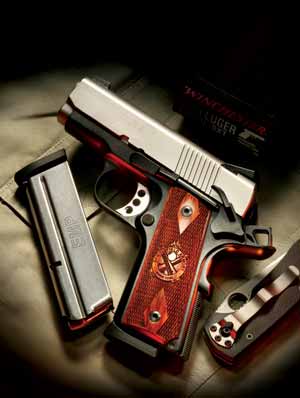
9mm Springfield 1911 subcompact
This gun is made of forged aluminum alloy with anodized black metal and a carved wooden hand grip. It’s a “pretty” gun . . . and you pay for that. This one runs around $1,200.
Seems like the bigger the gun or the more detailed, the more the prices rise. One site that shows good pictures and seems to quote representative prices is www.gundirectory.com.
A Note on Laser Sights and Night Lights
Some shooters think the world of laser sights, which can help you shoot with greater speed and accuracy. When you first begin training with a new gun (especially if it’s small with a very short barrel), a laser sight can help your aim as you get accustomed to the gun.
9mm Glock with a Laser Sight
With a laser, you can see precisely where you’ve pointed the muzzle of your gun, and if you’re off, it shows in a very big way. To find out more about lasers, go here: http://www.crimsontrace.com.
You can also get handguns outfitted with a flashlight at the end of the barrel like this .45 Heckler & Koch which is used by a lot of security forces around the world:
.45 Heckler & Koch
Don’t Forget Revolvers
I’ve focused on a lot of semi-auto guns, but rather than one of those or a smaller “purse gun” or “pocket piece,” perhaps your sleuth would do better with a revolver. With only a 3- or 4-inch barrel and a six-round cylinder, a revolver can fit unobtrusively in a lot of places on your person. Two examples would include the Smith & Wesson models below:
.38 Smith & Wesson “Snub-Nose” Model 36
.38 or .357 Smith & Wesson Model 66
S&W also makes this gun with a hammer that’s recessed so it’s less likely to catch on things in a purse or carry bag.
Some of the smaller .38 and .40 caliber revolvers are concealable. By the time you get to the steel-constructed .45s, such as the Ruger Redhawk, you’re getting into some size and weight. Fully loaded, this revolver below weighs slightly over four pounds. That’s some serious drag in your pocket or purse!
.45 Ruger Redhawk
Some Other Suitable Guns
Non-professional sleuths (incidental or amateur detectives) ought to have guns that suit them. Even if the weapon is one they’ll keep squirreled away in a shoebox in the closet (or in the cookie jar), why should it be a boring old Glock?
Maybe a .45 or 9mm or .357 is just too big for a woman with small hands. Take yourself to a gun store and ask the dealer to let you handle a variety of firearms. You’ll soon find a gun that you think is handsome, not too heavy, and that has a grip that fits your hand – or that fits the hand-size of your imagined sleuth.
The Kimber 1911 is a very cool gun and can be outfitted with a laser and night-sight. It’s a little big for an average woman’s hand, but it’d fit a man well.
.45 Kimber 1911 Stainless Pro Carry II
The full-size 9mm Beretta, carried by cops and the military, is comfortable to fire, though it’s a fairly heavy gun.
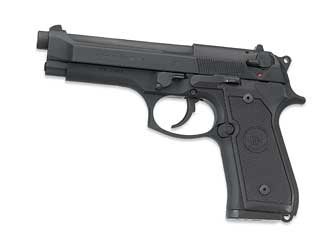
9mm Beretta 92FS
A durable and much-loved gun often passed from father to son (or father to daughter) is the .45 Colt Commander with the nice wood grip.
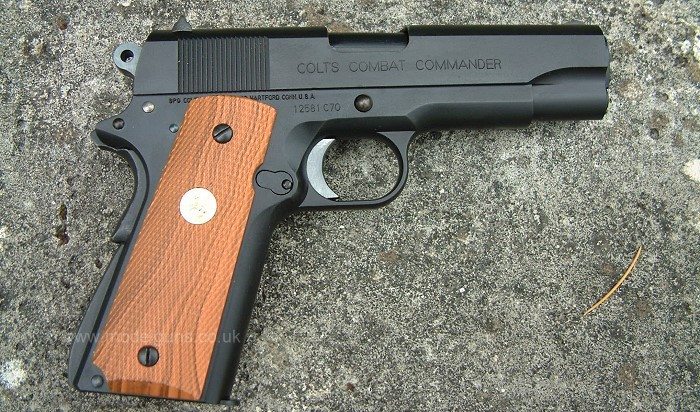
.45 Colt Combat Commander
Or maybe you should give your detective a long-barreled .44 Magnum like Dirty Harry carried.
.44 Smith & Wesson Magnum Model 29 – The Dirty Harry Gun
I shot that one, and it had some kick! (Or maybe your gal is like Dirty Harry – giving her a gargantuan .44 would definitely say something about her personality.)
I discovered that I love SIG-Sauer handguns, I have medium-sized hands for a woman, but small compared to the average man’s hand, and the Glock is so wide and clunky. A comfortable gun is one that will allow you to shoot with much better accuracy, and my dream gun, the SIG-Sauer P239, fits in my hand perfectly.
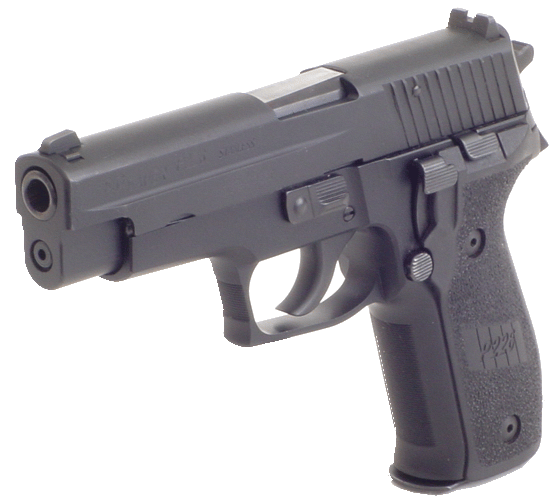
9mm SIG-Sauer P226
It’s smooth to operate and extremely durable (unlike a Glock, which *will* chip; you can slam a Sig around and it will not break), and since the Sig measures 7.7 inches overall and weighs only 29 ounces, it’s one of the lighter, ore compact medium-sized guns around.
For people who are curious about this, go to a gun store and compare the Glock to the Sig, or to any other gun. You will immediately see and feel that the Glock is bigger/clunkier. From side to side, the grip is much the same, but the butt is a bit larger, which is noticeable to women or men with smaller hands. It’s surprising how much a few millimeters in dimension make. The P226 has one of the most compact, comfortable handles of any 9mm featuring a double-column magazine, which makes it far superior to the Glock in terms of firing comfort.
My cop friends say that their Glocks jam periodically, but usually they’re quick and easy to clear. I recently fired a couple of boxes of rounds without a jam from a Glock 19, but my firing partner, a police officer, was firing a lot faster than I was, and with the heat of the gun, she had two jams. So Glocks are no strangers to jams – especially if you’re not religious about keeping them 100% cleaned. The Glock is a perfectly decent gun, but it’s a big, solid handful, and I’d much rather pack a SIG-Sauer P226 if you gave me a choice between the two.
Bottom Line: No woman character in her right mind would willingly carry and use a full-size Glock unless she had VERY big hands or at least quite a bit of finger/thumb spread. The gun is designed for a big, meaty, man’s hand. It doesn’t help that the gun is extra light either. The recoil is MUCH more significant than from some of the tighter, more compact, slightly heavier guns.
How Do You Write An Accurate Book? Research, research!
By now, you can see that there is SO MUCH VARIETY in firearms (and I haven’t even talked about rifles!). Really, if you’re a mystery writer and you’re ever going to have characters use any kind of weapons, you would be well served by visiting a well-stocked gun shop or wandering through a gun show. Ask questions, hold guns, examine ammo, work the slide, take the guns apart and put them back together, get a feel of the weight of various parts. Until you do that, I don’t know that it’s really all that easy to write a scene that feels “real.”
Up next week on Tuesday: Outfitting Your Crooks With Guns
“We’ll never forget you gave your all
That others can be free
You paid the ultimate earthly price
Immortal you will ever be.”
Susan Helene Kramer
*Tomorrow – Part 2 of Guns, Guns, Guns with Lori L. Lake
The hike up to the twin falls is a journey into another dimension. Towering evergreens and thick brush surround the entrance to the trail. Civilization is soon a million miles away. No cars, no ringing cell phones. The only sound is the occasional bird alerting others of approaching humans.
Moss-covered trees lean out into the path, their mossy fingers stretching, guiding passing hikers deeper into the woods.
The trails wind around, through, and over streams as clear as polished glass. The smell of wet stones and cool mud punctuates crisp morning air.
Soon, the earth begins to gently tremble beneath the hiker’s feet. The air fills with moisture as they near the falls.
Foamy, whitewater explodes at the head of the stream.
The falls send milky tendrils of water crashing to pools 100 feet below.
The watery fingers sway and dance with the ever-changing mountain breezes.
Standing, listening to the symphony of rushing waters, a bald eagle is heard screeching from above, a signal that it’s time to begin the long walk out, plunging back into the sea of green.

5-21-08 Joliet, Illinois Police Officer Richard Trafton received his department’s highest award this week, the prestigious Murrin Medal, as well as other Heroism and Lifesaving Awards. Officer Trafton saved the life of fellow police officer, Mike Sheridan, who had been stabbed twice during a scuffle with a violent offender. Trafton quickly pulled Sheridan to safety, and was then attacked by the same knife-wielding suspect. Officer Trafton was able to draw his service weapon and stopped the threat. Officer Sheridan received a Purple Heart during the same ceremony.
5-20-08 A 35 year old Harper Woods, Michigan police officer went well above the call of duty when he pushed two civilians to safety before he was struck by an out of control car. The unidentified officer saw the car careening toward the pair and quickly shoved them out of harms way. The officer was hit in the hip and back, but is expected to fully recover.
5-16-08 Roanoke, Virginia Police Officer Brian Lawrence was severely injured while attempting to arrest two suspects who’d assaulted a female. Officer Lawrence was paralyzed as a result of his injuries. It’s not known at this time if the paralysis is permanent. Police have not released details of Officer Lawrence’s injuries, but a search warrant filed in Roanoke’s Circuit Court (probably to retrieve evidence from the suspects) indicates a shoe print was visible on the officer’s head. Both suspects have been arrested and charged with malicious wounding of an officer.
The responsibility of protecting county courtrooms, judges, jury members, court employees, witnesses, and all citizens who attend court hearings and trials, falls on the shoulders of the county sheriff. The sheriff is also responsible for transporting jail inmates to and from their court appearances, and for guarding the prisoners while they’re inside the courthouse.
US Marshals have the responsibility of providing security and prisoner transport for federal courts.
Sheriffs deputies employed as court security officers undergo special training related to working in a court environment. Depending on an individual sheriff’s policy, court security officers may, or may not, be certified police officers.
The sergeant (you can tell he’s a sergeant by the three stripes on his sleeve and collar pin) in the above photograph is in charge of all courtroom security operations. In addition to supervising the deputies working in the various courtrooms, he’s responsible for delivering each prisoner to the correct courtroom on time.
Closed circuit cameras in each courtroom and other strategic locations, project real-time images to the security office. Judges also have panic buttons beneath their benches. A press of the button sends an emergency signal to the security office, and to police dispatchers and the nearby sheriffs office.
Deputies gather chains in preparation of transporting prisoners back to jail.

Court security officers must learn to use various screening devices, such as hand-held metal detecting wands and x-ray equipment.
Monitors for x-ray equipment.

Officer stationed at x-ray machine and walk-through metal detector.

Typical courtroom

Jury box

Prisoner holding cell in court basement near the security office.
Have you ever wondered how detectives capture those really cool, real-time, incriminating photos, videos, and audio recordings of criminals? It seems as if the cops are mere inches away when the bad guys are committing their crimes. How do they do it? Simple, they roll out the heavy artillery – surveillance vans.
Police surveillance vans can be disguised as the vehicles used by plumbers, TV repairmen, cable installers, and even the plain and simple mini-vans driven by soccer moms. It’s what’s on the inside that makes them so unique. The front, driver’s compartment is almost like a normal van. The only difference is a hidden intercom system used for communicating with the officers concealed in the rear compartment.
A hidden door behind the two front seats is the entrance to a cockpit that would make Captain Kirk green with envy. The secret compartment in a police surveillance van is equipped with separate heating, air conditioning that uses dry ice for cooling, extremely sensitive listening equipment that’s capable of monitoring all four outside corners of the truck, night vision, thermal imaging, GPS, video and still cameras, blackout curtains, police radios, CB radios (for monitoring citizen conversations) telephone, computers with internet service, and various printers for photographs and reports. Some are even equipped with toilet facilities. The people who build these vehicles even make use of the luggage racks on top. They’re used to conceal the antennas for the high-powered radio equipment.
Rear compartment of a police surveillance van.
Hidden intercom in center console of driver’s compartment.
360 degree surveillance periscope capable of video and still photography.
Joy stick for controlling periscope
Retracted periscope, When in use, the periscope has the appearance of a small roof fan.
The 2024 Writers’ Police Academy is a special event called Killer Con, which is designed to help writers create stunning realism in their work, Killer Con focuses on the intricate details surrounding the crime of murder and subsequent investigations.
Visit The WPA website to register!
*The Writers’ Police Academy (WPA) is held every year and offers an exciting and heart-pounding interactive and educational hands-on experience for writers to enhance their understanding of all aspects of law enforcement, firefighting, EMS, and forensics.
Lee Lofland is a nationally acclaimed expert on police procedure and crime-scene investigation, and is a popular conference, workshop, and motivational speaker.
Lee has consulted for many bestselling authors, television and film writers, and for online magazines. Lee has appeared as an expert on national television, BBC Television, and radio shows.
Lee is the host and founder of the Writers’ Police Academy, an exciting, one-of-a-kind, hands-on event where writers, readers, and fans learn and train at an actual police academy.
To schedule Lee for your event, contact him at lofland32@msn.com
